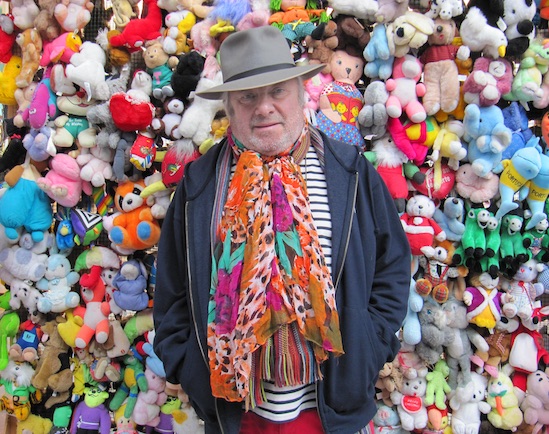Not many people know that before Charlemagne Palestine established himself as a composer and performer of intense, marathon pieces for piano he considered himself primarily a video artist, (before video was even a thing): developing a style of first person shooting which he called "subjective camera". In the 80s and 90s, while on semi-hiatus from performing, visual art and particularly film was his primary output. So, it was perhaps unsurprising that when we asked Palestine for a list of his favourite albums and he instead sent back a list of his favourite films.
That said, Palestine is also something of a contrarian. Famously when asked if he fit in with the inventors of minimalists like Riley, Glass and Reich, his contemporaries on the New York scene, he replied "if anything, I invented maximalism". Yet this contrarian attitude is not borne out of pure mischief, something he certainly exudes, but because he doesn’t much like labels and rules. Incidentally, he also doesn’t much like lists.
There are few artists in the modern composition zone who are more concerned with the visual and cinematic aspects of performing. As he told the Guardian, <a href="https://www.theguardian.com/artanddesign/2018/feb/01/charlemagne-palestine-18000-stuffed-animals-ccornuuoorphanossccopiaeeaanorphansshhornoffplentyyy/" target="out">
"I create a mise-en-scène each time I give a performance." His pianos are regularly adorned with an orgy of colourful soft toys and his eye-wateringly gaudy shirts are often complimented by multiple hats and scarves.
Carlemagne, is in fact, troubled by the art world’s artificial separation between mediums; between sound and vision (as well as the other senses). He likes to reference the concept of the Gesamtkustwerk (total work of art) in which all the different art forms music, painting, dance, film, etc. are combined together. He used to call himself a multi-media artist but "Gesamtkustwerk", he explains with mock Germanic fervour, "…is a word which has power! When you say that people open their eyes and their ears."
Born to Russian Jewish immigrants in Brooklyn, Charlemagne escaped what he called "the boonies" when he was accepted into New York’s prestigious Laguardia High School of Music where he was exposed to cutting edge culture, especially from Europe. He worked with the Buchla synthesizer in a studio above the Bleecker Street Cinema, which is where he first discovered "arty" films and the Nouvelle Vague.
He was a fixture of the New York scene as a teenager, known for playing (and sometimes improvising with) the carillon bells at St. Thomas’s Episcopal Church on 5th Ave. He shared the sidewalks with Rhys Chatham, Tony Conrad and Moondog even before making his most famous musical works. His key innovation was a technique he called "strumming" which consisted of repeatedly hitting notes on a piano with the sustain pedal down, in order to produce complex overtones (roughly what Glen Branca and Rhys Chatham would later do with guitars). Charlemagne would gradually build up notes in response, sometimes over the course of hours until it was difficult to distinguish which notes were "played" and which were sung back from the body of the piano. In the 2000s, after many of his early works were re-issued and rediscovered, he produced new compositions for piano The Apocalypse Will Bloom, bells Music for Big Ears, synths and the voice as well as countless collaborations with the likes of Pan Sonic, Tony Conrad and Rrose. He currently lives in Belgium and does much of his work in Europe.
One further reason why a music list might have proven difficult for Palestine, is that his influences are more oblique – he is less inspired by Western composers and more by Eastern music, (he trained with singer Pandit Pran Nath) and religious music, from his time as a carillonneur and as a cantor. His work also derives from exploring the hidden sonic properties of instruments like pianos and synthesisers coaxing unexpected effects from them by locating their limits.
As he explains, his list of films is intuitive rather than definitive – they often remind him of places he’s exhibited in or aspects of his Jewish heritage or connections he arrives at only in conversation. He talks in a warm and excitable way and his answers are often sprinkled with diversions like his overtones around a reference pitch.
If there is anything that links these disparate films to his music, it is that they are very long (several push three hours in length) and they tend to explore the confluences between sound and vision. And much like one of his immersive drones, they seem to ring in the air long after the credits roll.
Charlemagne Palestine is one of many artists appearing at this year’s Meakusma festival, taking place in Belgium this September – for more information and tickets, visit the festival website. Click on the image of Charlemagne below to read his cinematic choices


